
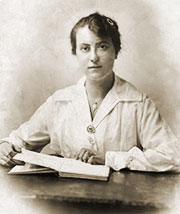

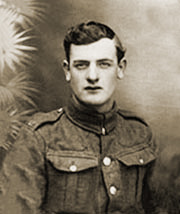

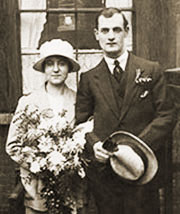

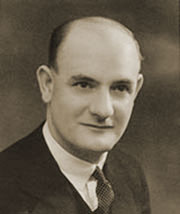

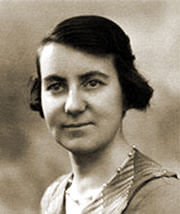

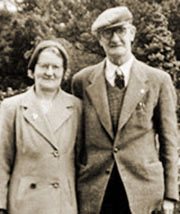
East of Eden
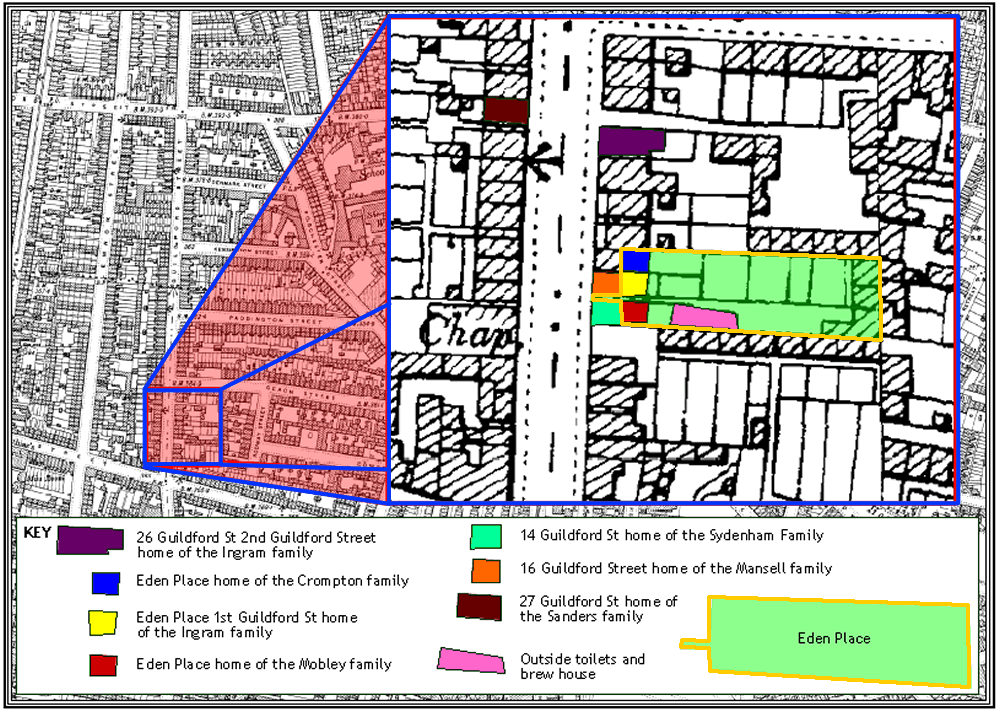
Part 1: Introduction and the Nineteen Tens and Twenties
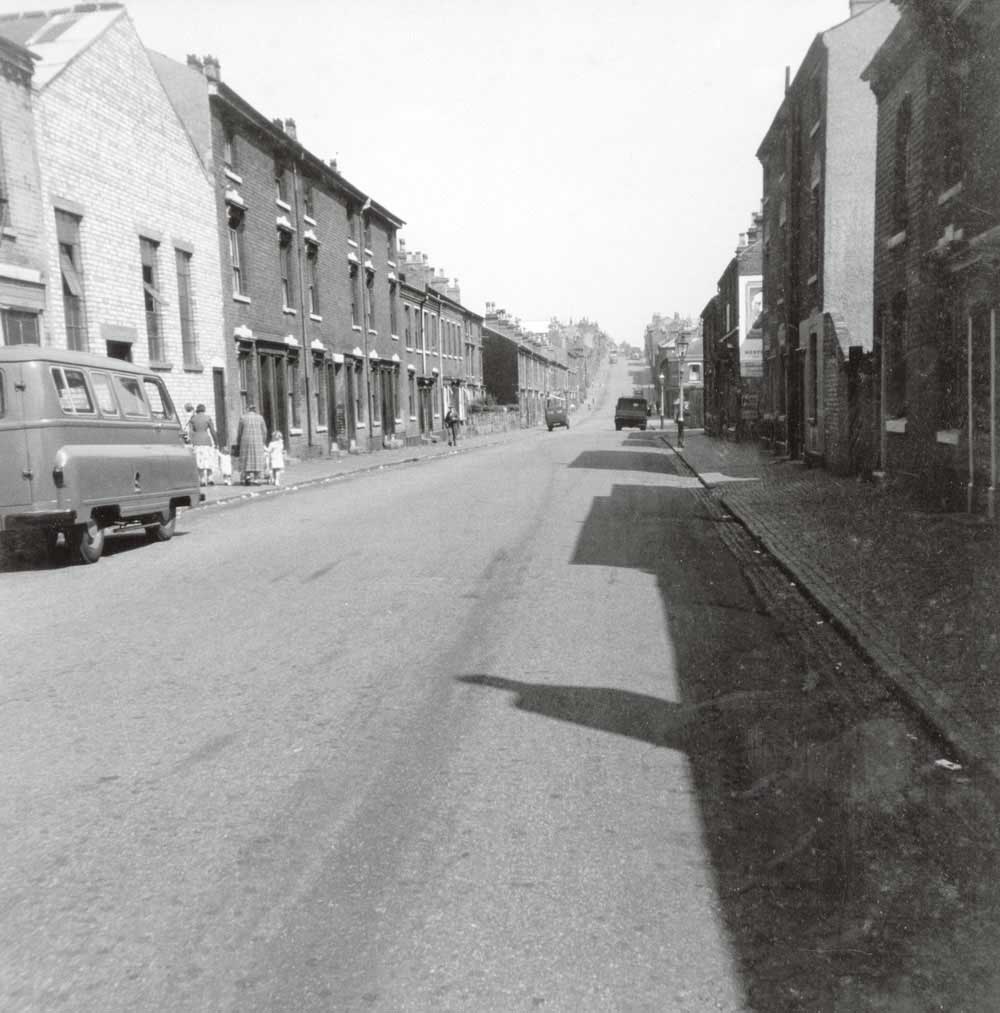
Guildford Street 1950s. Taken by Dennis Sanders (later Rev D D Sanders). Dennis lived at number 29 and married Olive Ingram from number 26
Eden Place was a court on the east side of Guildford Street half way between Geach Street and Farm Street. The entry leading to the court containing six back to back houses was between numbers 14 and 16 Guildford Street. My grandparents, Harry and Kate Crompton moved to number 6 Eden place sometime between 1901 and 1914. I was born in 1941 but I knew the house well. The Bagleys lived there then; Mr and Mrs Bagley, two sons and a daughter. The eldest son, Duncan was one of my childhood friends. It was a typical back to back; downstairs a small living room; a tiny scullery at the back with a sink, little more than a cupboard; one bedroom on the first floor and an attic bedroom above.
During the time that my grandparents lived there they had ten children. My uncle Ran, the eldest, not quite 16 in 1914 joined the army
with his friend Alf Ingram from 169 Wheeler Street. My mother, Doris was 15,
Alf, 4, Harry, 1 and Sid who was born that year. There had also been Victor who
was born in 1900 but died in 1907, Annie Amelia born 1902 and died 1906, Lilian Maria born 1904 who died at five months, Thomas Harry born 1905 and died in 1907 seven months before Victor and Robert Albert who died in 1910. My
grandfather also went to war leaving my gran with my mother and her three
youngest brothers living in the house.
After the war in 1922 my mother Doris Crompton married Alfred Ingram.
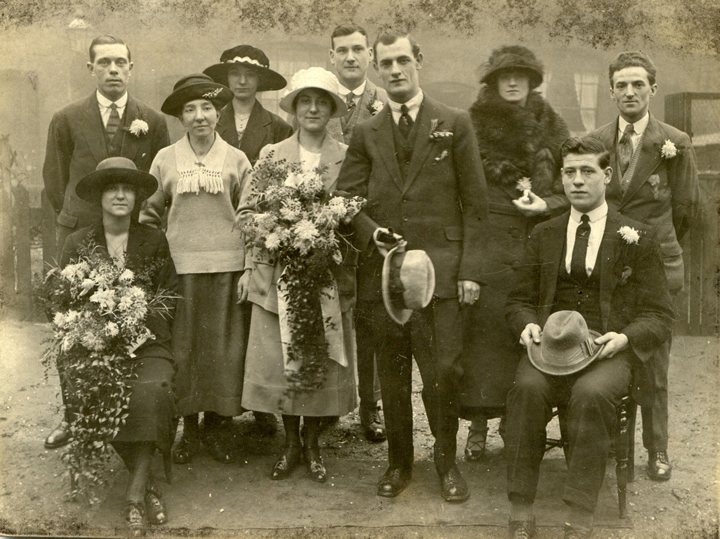
My Parents' Wedding 7 January 1922
My parents' wedding photograph it was taken in Eden Place. At the top of the photograph at the right you can see the entry with a lamp above it. Moving left is number 5 where Doris and Alf were to live later and on the right is number 6 where here parents were living. The woman to the left of my mother in the picture is my grandmother Kate Crompton. The man at the back between my mother and father is Thomas Lawley, brother of Sid Lawley who was the greengrocer in Farm Street in the '40s and '50s, (next door to C.V. Bull, the butcher on the corner of Farm Street and Lennox Street).
The young woman sitting at the front is Cissie (Elvira) Colesley. She worked with my mother enamelling brooches at Ashford's in Great Hampton Row; the building is still there. My father was a horse drawn bus driver; he had flue at the time.
At around this time my grandparents moved to Martley in Worcestershire. My parents moved into lodgings in New John Street West and in 1923 my sister Doris was born. They then moved into number 5 Eden Place. The family living at number 6 by then were the Bluettes. Over the next seven years the family grew. Alfred was born in 1924, Rene in 1927 and Olive in 1930. Mom and dad had the bedroom on the first floor, the children slept in the attic. When the children were older, a sheet was hung across the middle of the attic to act as a divider.
Part 2: The Nineteen Thirties and the Coronation
On the 12th May 1937 the whole country celebrated the coronation of King George V1 and Queen Elizabeth with street parties and of course so did the families of Eden Place
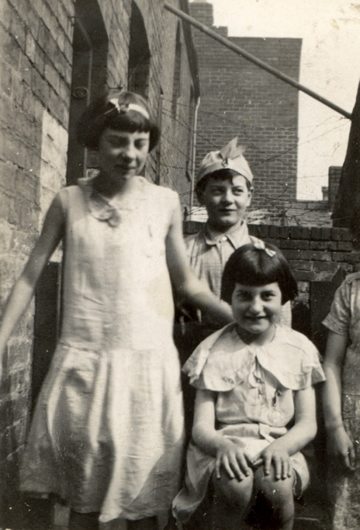
Doris, Alf and Rene Ingram outside number 5 Eden Place waiting for the party to start
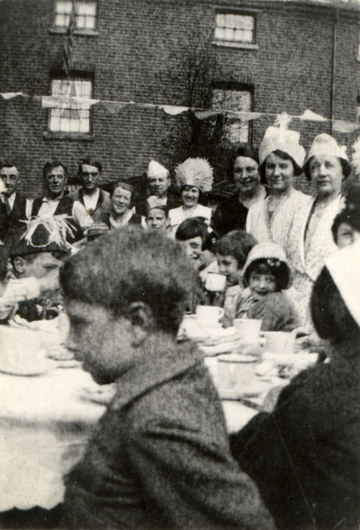
The party is underway Doris Ingram, my mother is second from the right with the party hat
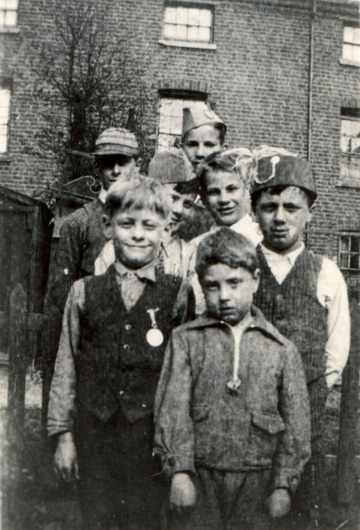
Unidentified group of boys with my brother Alf peeping from behind
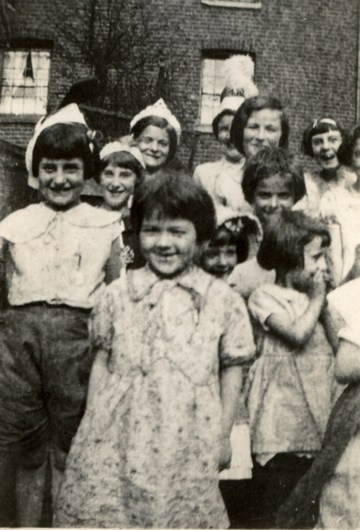
Group of girls. My sister Rene is on the far left and my sister Doris is on the right at the back, laughing. It is interesting that the boys and girls were photographed separately
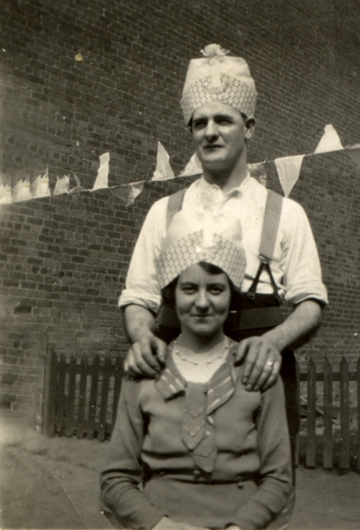
Alf and Doris Ingram, my parents. The enormous wall is the back of the houses from the next court down, 'The Barracks'
Part 3: Other Photos from Eden Place

Alf Ingram in the garden of number 5. The Building in the background is in 'The Barracks' - the court at the back of 26 Guildford Street. In the '40s and '50s the home of the Trotter family
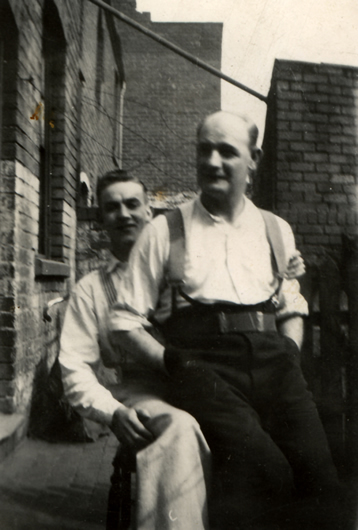
Alf Ingram and a neighbour outside number 5
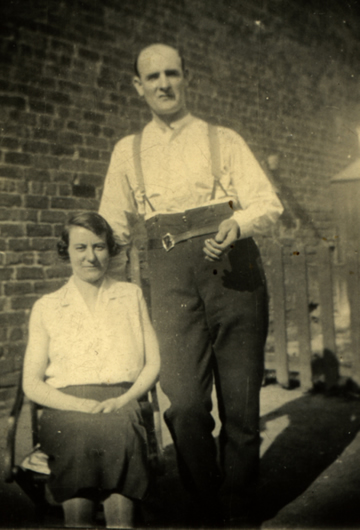
Doris and Alf Ingram
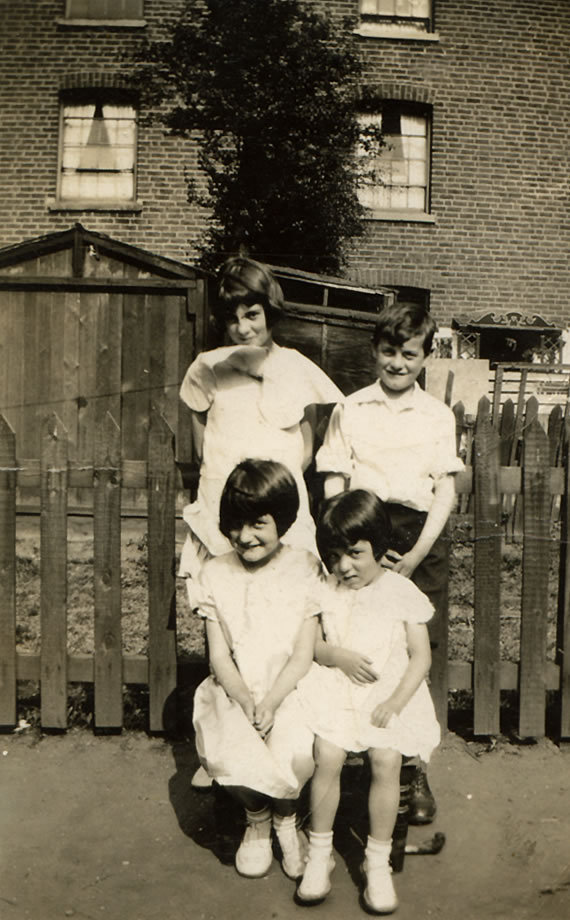
Clockwise from top left - Doris, Alf, Rene and Olive Ingram. Notice the decorative porch over the doorway at the back, that was still there in the `50s
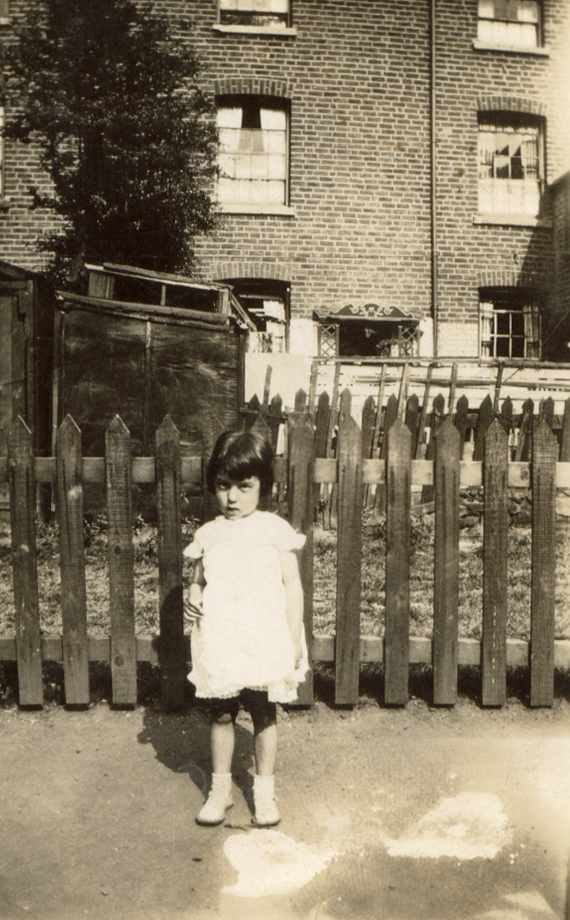
Olive Ingram
The diagram below shows the positions in Eden Place where I estimate the photographs were taken.
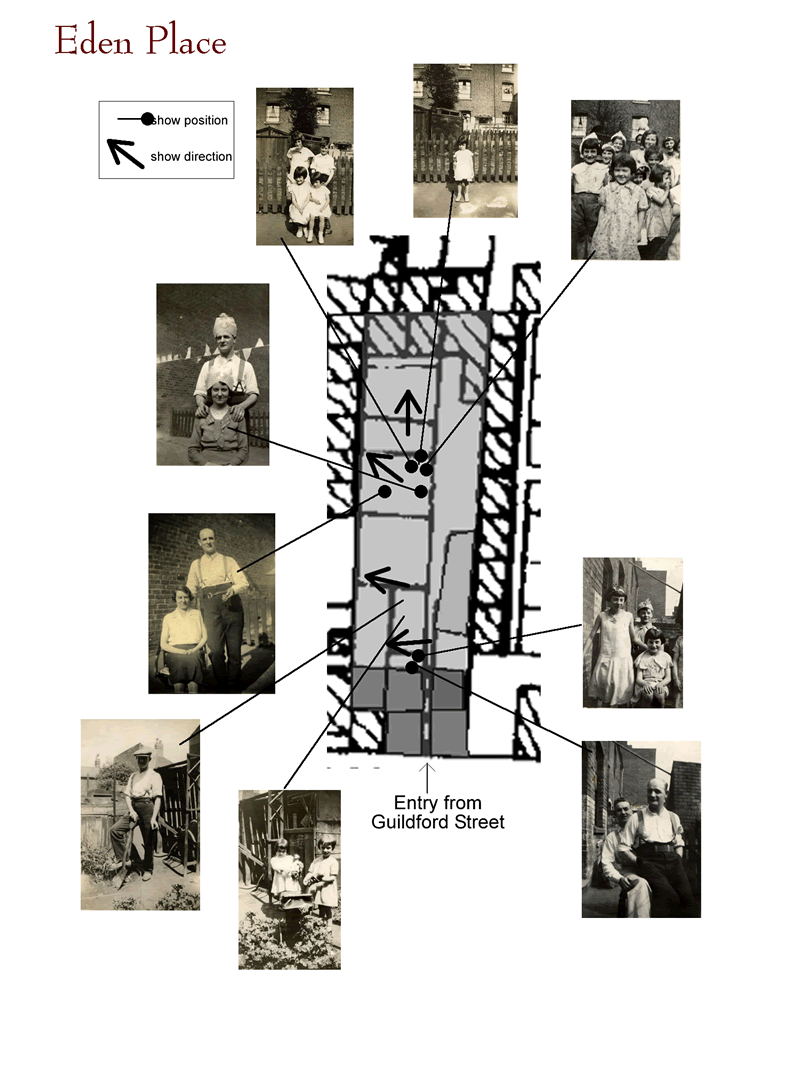
Part 4: The Nineteen Forties and Nineteen Fifties
By 1941 the Ingram family had left Eden Place and had moved to 26 Guildford Street. From the three roomed back to back they now lived in a house with its own private back yard and garden, their own outside toilet, a kitchen with its own copper boiler, a living room, a front room, and four bedrooms. No bathroom or hot water but it must have been like a dream home.
I was born there in June 1941. By the time I was about five or a little older I would play outside our yard in the court at the back of the house. The court had no official name other than 4 court, however, everyone knew it as 'the Barracks'. It was a large court of sixteen houses. My friends then were Johnny Wells who lived in the Barracks and his cousin Duncan Bagley; both the same age as me.
Duncan lived in number 6 Eden Place, my grand parents' previous home. It was many years later that I came to know that my family had lived in number 5 and 6.
The houses in Eden Place were back to back but they all had gardens surrounded by palings. Most were cultivated as they were when my family lived there; flowers and vegetables, dug for victory. The Bagley's garden was bare earth, a playing area for the two sons and friends. I don't think Mr Bagley was keen on gardening. The elder sister was older than we were left home in her late teens. There may also have been a baby girl but I`m not sure. We all played there sometimes and also in the drying grounds but mostly we played in the Barracks or in the horse road with other children.
The court was quite long, three houses each end. Along the right hand side facing away from the entry, against a high wall were the outside lavatories and the brew house (the Brummie word for wash house). Above them there was a workshop reached by wooden stairs; I never new what the workshop was used for. As far as I was concerned, the stairs were for playing cowboys and indians. The paling fences were where we tied our imaginary horses and the Drying Ground was the great plains where the possie would ride.
The Drying Ground in Eden Place was a large empty space in the centre of the court, used on Mondays for the communal drying of washing; it was where the Coronation party had taken place. Each year on November the 5th there was a bonfire on the Drying Ground. This was the case in courts all over Birmingham at that time. On VE day the bonfires were burnt in the middle of streets. On the days around bonfire night families hid any thing that was wooden outside their houses, especially the washing line prop otherwise it would become part of the bonfire. On the night of the bonfire we kids would be wearing our knitted Balaclava helmets and have our pockets stuffed with five shillings worth of fireworks. In the time leading up to bonfire night we would park ourselves at the corner of Guildford Street and Farm Street, outside Mather's pawn shop to collect pennies for the guy. I don't think we collected much.
One year when we were approaching our teens and preferred bangers to sparklers Duncan put a banger in a milk bottle and stood by to see what happened. Of course, he was taken to hospital but was lucky. The glass didn't go into his eyes but it was close and he had stitches.
My parents had close friends that we often visited. Horace and Ruby Mobley. The Mobley's lived in Kingstanding and had a television early in the `50s. They always had the latest gadgets to enhance viewing. At one time it was a massive piece of thick plastic shaped as a magnifying glass, strapped in front of the television screen. Later a piece of plastic fading from red through green to blue which was fixed in front of the black and white television screen intended to simulate coloured television. I now know that that the friendship had begun in Eden place. In the '20s and '30s they lived at the other side of the entry to my parents.
Two or three time a year Mrs Mansell would arrive at 26 Guildford Street. Mom would get us up extra early when she was coming to get as many jobs done as possible and to get me off to school. Mrs Mansell would arrive early. I would leave for Burbury Street School with mom sitting in the arm chair nodding as she listened to Mrs. Mansell. I would arrive home after school and there was mom sitting in the armchair nodding as she listened to Mrs Mansell.
Some of her family had emigrated to Australia. In the early '60s and in her mid eighties she went out there to visit them. At the time I knew her she lived at the top of Guildford Street near Lozells Road. I now know that she had once lived at the top of the entry to Eden Place at number 16 Guildford Street and had been a family friend since the `20s.
There were also the Sydenhams who lived in the house at the back of number 6.
As I and my friends grew older as the '40s ended and the '50s began, our Eden extended out into the whole of Guildford Street and beyond. Its boundaries became Wheeler Street in the west, Lozells Road in the north, Farm Street in the south and Newtown Row in the East. And of course this included the cinemas. Johnny and Duncan would go to the Globe in Newtown Row but I rarely would. It was either the Orient near Sixways, The Villa Cross at the end of Lozells Road or the Palladium at Hockley Brook. I think it was the Palladium where I saw James Dean in East of Eden. I was well into my twenties when I read the novel. In the early `60s I was the only one living at home with my parents. After my father died in 1963 my mother got an exchange to North Walk in West Heath and I went to Art College.
I never saw Eden Place again.

Part 1: Introduction and the Nineteen Tens and Twenties

Guildford Street 1950s. Taken by Dennis Sanders (later Rev D D Sanders). Dennis lived at number 29 and married Olive Ingram from number 26
Eden Place was a court on the east side of Guildford Street half way between Geach Street and Farm Street. The entry leading to the court containing six back to back houses was between numbers 14 and 16 Guildford Street. My grandparents, Harry and Kate Crompton moved to number 6 Eden place sometime between 1901 and 1914. I was born in 1941 but I knew the house well. The Bagleys lived there then; Mr and Mrs Bagley, two sons and a daughter. The eldest son, Duncan was one of my childhood friends. It was a typical back to back; downstairs a small living room; a tiny scullery at the back with a sink, little more than a cupboard; one bedroom on the first floor and an attic bedroom above.
During the time that my grandparents lived there they had ten children. My uncle Ran, the eldest, not quite 16 in 1914 joined the army
with his friend Alf Ingram from 169 Wheeler Street. My mother, Doris was 15,
Alf, 4, Harry, 1 and Sid who was born that year. There had also been Victor who
was born in 1900 but died in 1907, Annie Amelia born 1902 and died 1906, Lilian Maria born 1904 who died at five months, Thomas Harry born 1905 and died in 1907 seven months before Victor and Robert Albert who died in 1910. My
grandfather also went to war leaving my gran with my mother and her three
youngest brothers living in the house.
After the war in 1922 my mother Doris Crompton married Alfred Ingram.

My Parents' Wedding 7 January 1922
My parents' wedding photograph it was taken in Eden Place. At the top of the photograph at the right you can see the entry with a lamp above it. Moving left is number 5 where Doris and Alf were to live later and on the right is number 6 where here parents were living. The woman to the left of my mother in the picture is my grandmother Kate Crompton. The man at the back between my mother and father is Thomas Lawley, brother of Sid Lawley who was the greengrocer in Farm Street in the '40s and '50s, (next door to C.V. Bull, the butcher on the corner of Farm Street and Lennox Street).
The young woman sitting at the front is Cissie (Elvira) Colesley. She worked with my mother enamelling brooches at Ashford's in Great Hampton Row; the building is still there. My father was a horse drawn bus driver; he had flue at the time.
At around this time my grandparents moved to Martley in Worcestershire. My parents moved into lodgings in New John Street West and in 1923 my sister Doris was born. They then moved into number 5 Eden Place. The family living at number 6 by then were the Bluettes. Over the next seven years the family grew. Alfred was born in 1924, Rene in 1927 and Olive in 1930. Mom and dad had the bedroom on the first floor, the children slept in the attic. When the children were older, a sheet was hung across the middle of the attic to act as a divider.
Part 2: The Nineteen Thirties and the Coronation
On the 12th May 1937 the whole country celebrated the coronation of King George V1 and Queen Elizabeth with street parties and of course so did the families of Eden Place

Doris, Alf and Rene Ingram outside number 5 Eden Place waiting for the party to start

The party is underway Doris Ingram, my mother is second from the right with the party hat

Unidentified group of boys with my brother Alf peeping from behind

Group of girls. My sister Rene is on the far left and my sister Doris is on the right at the back, laughing. It is interesting that the boys and girls were photographed separately

Alf and Doris Ingram, my parents. The enormous wall is the back of the houses from the next court down, 'The Barracks'
Part 3: Other Photos from Eden Place

Alf Ingram in the garden of number 5. The Building in the background is in 'The Barracks' - the court at the back of 26 Guildford Street. In the '40s and '50s the home of the Trotter family

Alf Ingram and a neighbour outside number 5

Doris and Alf Ingram

Clockwise from top left - Doris, Alf, Rene and Olive Ingram. Notice the decorative porch over the doorway at the back, that was still there in the `50s

Olive Ingram
The diagram below shows the positions in Eden Place where I estimate the photographs were taken.

Part 4: The Nineteen Forties and Nineteen Fifties
By 1941 the Ingram family had left Eden Place and had moved to 26 Guildford Street. From the three roomed back to back they now lived in a house with its own private back yard and garden, their own outside toilet, a kitchen with its own copper boiler, a living room, a front room, and four bedrooms. No bathroom or hot water but it must have been like a dream home.
I was born there in June 1941. By the time I was about five or a little older I would play outside our yard in the court at the back of the house. The court had no official name other than 4 court, however, everyone knew it as 'the Barracks'. It was a large court of sixteen houses. My friends then were Johnny Wells who lived in the Barracks and his cousin Duncan Bagley; both the same age as me.
Duncan lived in number 6 Eden Place, my grand parents' previous home. It was many years later that I came to know that my family had lived in number 5 and 6.
The houses in Eden Place were back to back but they all had gardens surrounded by palings. Most were cultivated as they were when my family lived there; flowers and vegetables, dug for victory. The Bagley's garden was bare earth, a playing area for the two sons and friends. I don't think Mr Bagley was keen on gardening. The elder sister was older than we were left home in her late teens. There may also have been a baby girl but I`m not sure. We all played there sometimes and also in the drying grounds but mostly we played in the Barracks or in the horse road with other children.
The court was quite long, three houses each end. Along the right hand side facing away from the entry, against a high wall were the outside lavatories and the brew house (the Brummie word for wash house). Above them there was a workshop reached by wooden stairs; I never new what the workshop was used for. As far as I was concerned, the stairs were for playing cowboys and indians. The paling fences were where we tied our imaginary horses and the Drying Ground was the great plains where the possie would ride.
The Drying Ground in Eden Place was a large empty space in the centre of the court, used on Mondays for the communal drying of washing; it was where the Coronation party had taken place. Each year on November the 5th there was a bonfire on the Drying Ground. This was the case in courts all over Birmingham at that time. On VE day the bonfires were burnt in the middle of streets. On the days around bonfire night families hid any thing that was wooden outside their houses, especially the washing line prop otherwise it would become part of the bonfire. On the night of the bonfire we kids would be wearing our knitted Balaclava helmets and have our pockets stuffed with five shillings worth of fireworks. In the time leading up to bonfire night we would park ourselves at the corner of Guildford Street and Farm Street, outside Mather's pawn shop to collect pennies for the guy. I don't think we collected much.
One year when we were approaching our teens and preferred bangers to sparklers Duncan put a banger in a milk bottle and stood by to see what happened. Of course, he was taken to hospital but was lucky. The glass didn't go into his eyes but it was close and he had stitches.
My parents had close friends that we often visited. Horace and Ruby Mobley. The Mobley's lived in Kingstanding and had a television early in the `50s. They always had the latest gadgets to enhance viewing. At one time it was a massive piece of thick plastic shaped as a magnifying glass, strapped in front of the television screen. Later a piece of plastic fading from red through green to blue which was fixed in front of the black and white television screen intended to simulate coloured television. I now know that that the friendship had begun in Eden place. In the '20s and '30s they lived at the other side of the entry to my parents.
Two or three time a year Mrs Mansell would arrive at 26 Guildford Street. Mom would get us up extra early when she was coming to get as many jobs done as possible and to get me off to school. Mrs Mansell would arrive early. I would leave for Burbury Street School with mom sitting in the arm chair nodding as she listened to Mrs. Mansell. I would arrive home after school and there was mom sitting in the armchair nodding as she listened to Mrs Mansell.
Some of her family had emigrated to Australia. In the early '60s and in her mid eighties she went out there to visit them. At the time I knew her she lived at the top of Guildford Street near Lozells Road. I now know that she had once lived at the top of the entry to Eden Place at number 16 Guildford Street and had been a family friend since the `20s.
There were also the Sydenhams who lived in the house at the back of number 6.
As I and my friends grew older as the '40s ended and the '50s began, our Eden extended out into the whole of Guildford Street and beyond. Its boundaries became Wheeler Street in the west, Lozells Road in the north, Farm Street in the south and Newtown Row in the East. And of course this included the cinemas. Johnny and Duncan would go to the Globe in Newtown Row but I rarely would. It was either the Orient near Sixways, The Villa Cross at the end of Lozells Road or the Palladium at Hockley Brook. I think it was the Palladium where I saw James Dean in East of Eden. I was well into my twenties when I read the novel. In the early `60s I was the only one living at home with my parents. After my father died in 1963 my mother got an exchange to North Walk in West Heath and I went to Art College.
I never saw Eden Place again.